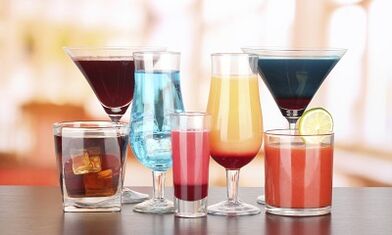
It's not enough to know your "norm", you need to be able to calculate properly, without disappearing in a variety of drinks, their fort and the size of the glass. So that people can monitor how much they drink, in 1987 in the UK introducing the concept of "unit" - a unit of alcohol. This method of alcohol accounting is very simple and has been maintained in other countries in the world.
One unit of alcohol is equal to 10 ml or 8 g of pure ethanol, which is about the amount of alcohol, which the body of the adult can be processed within an hour. Theoretically, this means that in an hour in the blood of adults it will not have almost no alcohol effect, although individuals have the rate of removal of alcohol from the body may vary.
In line with the above, there are allowed alcohol standards, the excess is harmful to health. These:
- No more than 3-4 units of alcohol daily for men;
- No more than 2-3 units of alcohol daily for women.
Keep in mind that this does not refer to the average alcohol use in a few days, which is the maximum amount of alcohol allowed in one day.
At the same time, a strong number of drinks cannot exceed a week:
- For women - 14 units;
- For men - 21 units.
If you drink excess alcohol a day before, refrain from alcohol within the next 48 hours.
From unit to "drin"
The number of units of alcohol in the drink depends on the fort and the amount of intoxication. So:
- A glass of wine (250 ml) of 12% forts contain about 3 units of alcohol;
- Bank of Beer (1 L) of 5% fortress contains about 4 units of alcohol;
- A pile of vodka (25 ml) of a 40% fort contains about 1 unit of alcohol.
Therefore, the daily norms allowed, on average, are:
- a glass of wine during dinner;
- about half a normal fortress beer;
- 2-3 small arrangement of vodka.
For exotic alcoholic beverages and cocktails, the formula will be useful with which you can calculate the number of units in a variety of drinks:
- Fort (%) x Volume (ml) ÷ 1000 = unit of alcohol.
How to reduce harm from alcohol?
Once in the body, alcohol is absorbed in the stomach, and then with blood flow spread through the body, easily penetrating all tissues and organs. The maximum concentration of alcohol in the blood is observed about an hour after its use, this is the most powerful intoxication and euphoria. Next, alcohol enters processing.
In the first stage, water molecules break from ethanol, and aldehyde vinegar. This is a poison for the body, intoxicated and the next drunk is associated with it. In the second stage, the aldehyde turns into acetic acid, which is not toxic and destroyed to carbon dioxide and water with energy. Two enzymes are controlled by the process of separating alcohol: alcohol dehydroginase (ADG) and acetaldehyddehydrogenase (Aldg). Their work speed is a natural genetic feature.
In someone with fast ADG and Aldg, the alcohol in the body is not long, and aldehyde quickly breaks down harmful substances. Such men are drunk slowly and do not experience strong intoxication. About people with slow enzymes they say they don't know how to drink: they quickly reach crazy conditions, which are replaced by severe intoxication. But the worst of everyone with ADG is fast and slow Aldg. People like that are not drunk, managing to drink more than they are, and aldehyde vinegar is quickly formed in the body for a long time, has a destructive effect.
Therefore, the drunkenness and subsequent poisoning depend, on a large -scale, only on the amount of intoxication and heredity. However, there are tricks that allow you to reduce the dangers of alcohol. To do this, slow absorption of alcohol from the stomach or reduce the amount of alcohol taken "by collar. "
- Peeling alcohol (beer, champagne) cannot be mixed with strong drinks. Carbon dioxide "magic bubble" accelerates the absorption of alcohol and increases its concentration in the blood, thus the severity of intoxication.
- Hot alcohol (punch, grog) and enriched wine need to be consumed moderately for the soul. Sugar and high temperature accelerate the flow of alcohol into the blood and the formation of acetaldehyde.
- Before and during festivals, you need to eat well, especially fatty foods. In this case, alcohol assimilation will be slowed down and its harm is reduced to a minimum of possible. Alcohol on an empty stomach can lead not only for fast intoxication, but also to harmful hypoglycemia.
- Stretch the time between the toast and drink small amounts of hemorrhoids and glasses to reduce the concentration of alcohol in the blood.
- Do not drink aspirin before and during the party. Acetylsalicylic acid slows down the absorption of alcohol, but causes ulcerative damage to the stomach and increases the risk of bleeding.
- Caffeine extends the duration of activity on the table, but in combination with alcohol, it can lead to the development of hypertension crisis and cardiac arrhythmias.
If you regularly drink alcohol, it is useful to take blood biochemical tests 2-3 times a year and visit a therapist. To protect the liver and brain from the effects of alcohol, hepatoprotectors and vitamin preparations as prescribed by your doctor are recommended.
Do I need to drink "for health"?
Contrary to the widespread opinion, there is currently no convincing evidence that the modest amount of alcohol benefits the liver and cleansing the vessel. There is no evidence that any of the alcoholic beverages have the advantage of others, in terms of influence on the cardiovascular system.
Therefore, you cannot drink alcohol with the goals of "therapeutic" those who do not have such a habit. The use of small and moderate doses of alcohol is not the prevention of cardiovascular disease.































